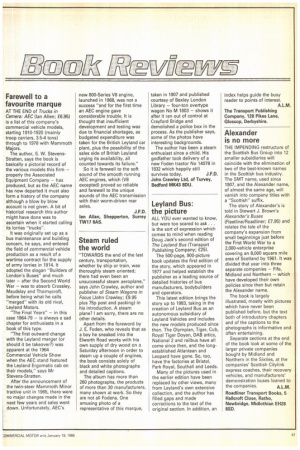Farewell to a favourite marque
Page 49

If you've noticed an error in this article please click here to report it so we can fix it.
AT THE END of Trucks in Camera: AEC (Ian Allen; £6.95) is a list of this company's commercial vehicle models, starting 1910-1920 (mainly troop carriers, 3.5-4 tons) through to 1978 with Mammoth Majors.
The author, S. W. StevensStratten, says the book is basically a pictorial record of the various models this firm — properly the Associated Equipment Company — has produced, but as the AEC name has now departed it must also form a history of the company although a blow by blow account is not given. A bit of historical research this author might have done was to ascertain when it started calling its lorries "trucks".
It was originally set up as a bus maintenance and building concern, he says, and entered the field of commercial vehicle production as a result of a wartime contract for the supply of army lorries in 1914. It adopted the slogan "Builders of London's Buses" and much later — after the Second World War — was to absorb Crossley, Maudslay and Thornycroft, before being what he calls "merged" with its old rival, Leyland Motors.
"The Final Years" — in this case 1964-79 — is always a sad chapter for enthusiasts in a book of this type.
''The first outward change with the Leyland merger (or should it be takeover?) was apparent at the 1964 Commercial Vehicle Show when the AEC stand featured the Leyland Ergomatic cab on their models," says Mr Stevens-Stratten.
After the announcement of the twin-steer Mammoth Minor tractive unit in 1965, there were no major changes made in the next few years and sales went down. Unfortunately, AEC's new 800-Series V8 engine, launched in 1968, was not a success "and for the first time an AEC engine gave considerable trouble. It is thought that insufficient development and testing was due to financial shortages, as budgeted expenditure was taken for the British Leyland car plant, plus the possibility of the sales side of British Leyland urging its availability, all counted towards its failure."
So it is farewell to the soft sound of the smooth running AEC engines, which (V8 excepted) proved so reliable and farewell to the unique sounds of the AEC transmission with their worm-driven rear axles.
J.F.D.
Ian Allan, Shepperton, Surrey TW17 8AS.














































































